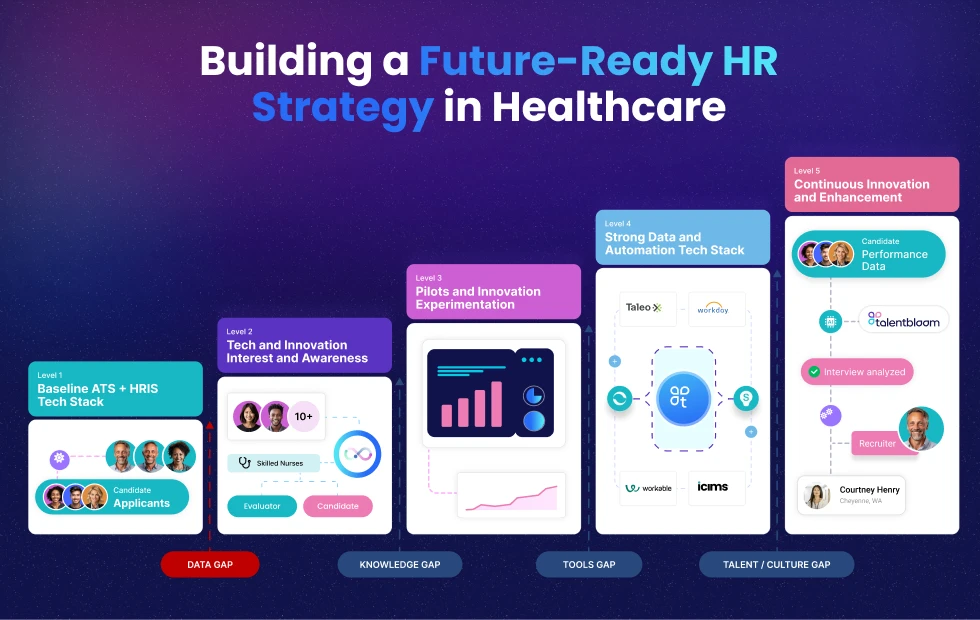
In the fast-paced world of healthcare, staying ahead of the curve in talent management and HR practices is crucial. At TalentBloom our research has shown that 7 out of 10 healthcare talent leaders rate their organizations between level 1 and level 3 on the innovation preparedness scale. This indicates a significant opportunity for growth and development with HR innovation in healthcare.
This article provides healthcare HR leaders with valuable insights into each level of innovation preparedness and offers practical strategies to navigate this transformative process in a world increasingly driven by AI and advanced technologies. By understanding the key characteristics and requirements of each level, leaders can better assess their current standing and chart a clear path forward. To start, here are several key points to consider.
- As I leader do I foster a culture of innovation within my HR and talent teams?
- Is my team investing in building strong relationships with the IT and Digital Transformation departments as this is crucial for encouraging collaboration and leveraging technological advancements?
- Are we focused on outcomes-based discussions, rather than feature or “cool tech” based discussions to align internal stakeholders with new, potentially uncomfortable ideas that push the boundaries of traditional HR and talent management practices?
- Have we mastered the process of turning raw information into actionable data? A key aspect of advancing through these levels is the integration of clean, high-quality data into your talent tech stack.
Through these efforts, HR leaders can drive meaningful change and position their organizations at the forefront of HR innovation in healthcare. Let’s explore the five levels of innovation preparedness and provide actionable strategies for healthcare HR leaders to mature from one level to the next.
Level 1: Baseline ATS + HRIS Tech Stack
At the foundational level, organizations typically have a basic Applicant Tracking System (ATS) and Human Resource Information System (HRIS) in place. While these systems are essential, they often lack the capabilities needed to drive innovation.
Strategies to Advance:
- Audit Your Current Systems: Conduct a thorough audit of your existing ATS and HRIS to identify gaps and limitations.
- Data Clean-Up Initiatives: Implement data clean-up initiatives to ensure that the information stored in these systems is accurate and up-to-date.
- Integration Exploration: Start exploring integration possibilities with other tools that can enhance data quality and utility.
Level 2: Tech and Innovation Interest and Awareness
At this stage, there is a budding interest in innovation, but no formal roadmap or strategic plan is in place. Organizations are in the “just exploring” phase.
Strategies to Advance:
- Form an Innovation Committee: Create a dedicated team to explore and evaluate new technologies and innovation opportunities.
- Attend Industry Conferences: Encourage team members to attend industry conferences and webinars to stay abreast of the latest trends and innovations in HR tech.
- Pilot Programs: Start small by implementing pilot programs for promising technologies to gauge their effectiveness and fit within your organization.
Level 3: Pilots and Innovation Experimentation
Organizations at this level have moved beyond mere interest and are actively experimenting with new technologies through pilot programs.
Strategies to Advance:
- Measure and Analyze: Develop metrics to assess the success of pilot programs and make data-driven decisions about broader implementation.
- Seek Feedback: Gather feedback from users and stakeholders to refine and improve the pilot initiatives.
- Scale Successful Pilots: Identify successful pilot programs and create a plan to scale them across the organization.
Level 4: Strong Data and Automation Tech Stack
By this stage, organizations have a robust tech stack that includes multiple automation tools, and workflow changes have been made to support innovation.
Strategies to Advance:
- Invest in Advanced Analytics: Enhance your tech stack with advanced analytics tools to gain deeper insights into your talent data.
- Optimize Workflows: Continuously review and optimize workflows to ensure they support the seamless integration of new technologies.
- Training and Development: Provide ongoing training and development opportunities for staff to maximize the use of new tools and technologies
Level 5: Continuous Innovation and Enhancement
At the pinnacle of innovation preparedness, organizations have embedded data automation and AI into their business and talent management DNA. Innovation is a continuous process, and the organization is always looking for ways to enhance its capabilities.
Strategies to Sustain and Enhance:
- Continue to Foster a Culture of Innovation: Cultivate a culture that encourages creativity, experimentation, and continuous improvement.
- Stay Ahead of Trends: Keep a close eye on emerging trends and technologies in HR and talent management to remain at the forefront of innovation.
- Regular Reviews and Updates: Regularly review and update your tech stack and processes to ensure they remain aligned with the latest advancements and organizational goals.
Innovation preparedness is a journey that requires commitment, strategy, and continuous effort. By understanding the five levels of innovation preparedness and implementing the strategies outlined above, healthcare HR leaders can build a resilient, forward-thinking HR function that leverages the latest technologies to attract, retain, and develop top talent. Embrace this journey as an opportunity to transform your HR practices and drive long-term success in the healthcare industry.